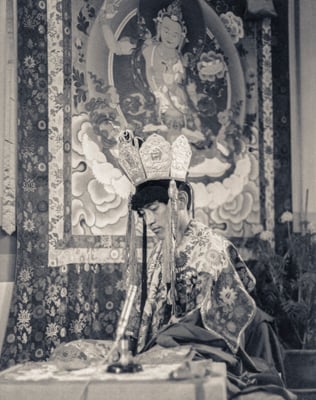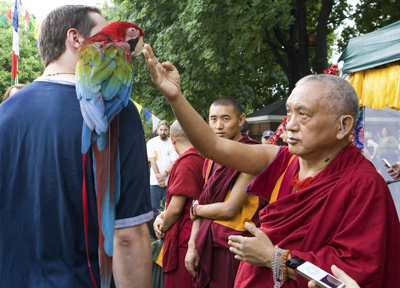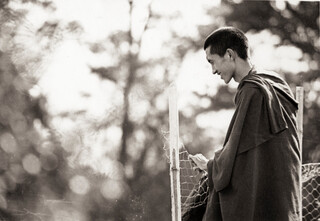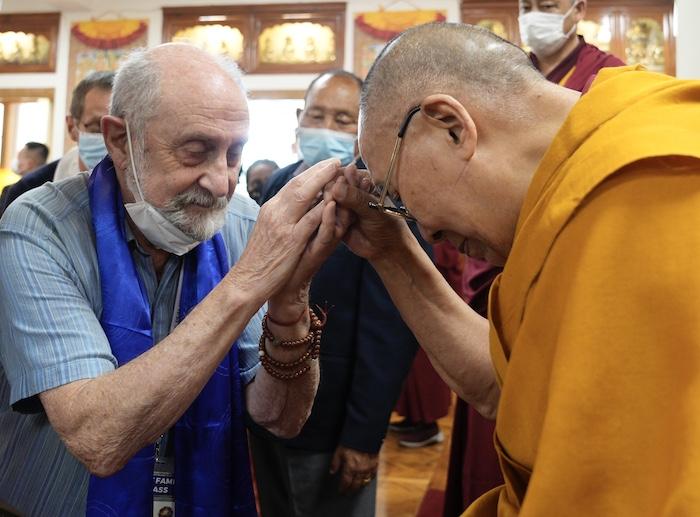Dear Friends,
As you read this, I’m at Kopan Monastery, where many people have gathered to commemorate the final few days of the forty-nine since the unbearable tragedy of the passing of our infinitely kind, precious and irreplaceable guru, Lama Zopa Rinpoche.
I got here a couple of weeks ago and made a side trip to Dharamsala, India, where on the 24th we, the FPMT, offered a long life puja to His Holiness the Dalai Lama, which had been Rinpoche’s wish for three years. That he was not there made the occasion incredibly poignant. But it was a huge success, and during it His Holiness in turn offered great praise to Rinpoche: his life, his work and his example.
The next day His Holiness kindly granted all the FPMT students, more than four hundred of us, an audience. Apparently he was going to speak for about ten minutes but finished up talking for an hour or so. It was a surprisingly intimate talk, about his life and accomplishments, and he also reassured us that we had his full support and that he would pay close personal attention to finding the unmistaken reincarnation of Lama Zopa Rinpoche.
One of the interesting things His Holiness mentioned was a lucid dream he’d had in which Palden Lhamo told him that he would live for another twenty or thirty years. As we know, His Holiness will be eighty-eight this year.
 A transcript should be available soon and we will share it on our social media.
A transcript should be available soon and we will share it on our social media.
At the end we were all able to file past and receive his blessings. I cheekily stopped and asked His Holiness for another twenty years (I just turned eighty-two) in order to make many more of Lama Yeshe’s and Lama Zopa Rinpoche’s teachings available. He didn’t say anything but did grab my hands and touch them to his forehead. I’m taking that as an OK!
If you haven't already, please read the Beautiful Mandala– An Intimate Portrait of this Time from Ven. Sarah Thresher, a deeply touching account of the days and weeks at Kopan after Rinpoche's passing.
From the Video Archive: Expressing Joyful Gratitude & Offering Spontaneous Teachings
This month from the LYWA video archive, we bring you impromptu footage of Lama Zopa Rinpoche and Khandro Tseringma at a gathering following a series of formal teachings given by Lama Zopa Rinpoche in 2013 at Tushita Meditation Centre in Dharamsala, India. In this video Rinpoche praises the wonderful karma of the cooks who fed the retreatants and describes how their efforts have supported the Dharma. Then Rinpoche entreats Khandrola to give a Dharma teaching to the gathering, which she does with Geshe Kelsang Wangmo translating.
Visit and subscribe to the LYWA YouTube channel to view more videos freely available from our archive. See also the FPMT YouTube channel for many more videos of Lama Zopa Rinpoche’s teachings.
On the LYWA Podcast: How Guru Shakyamuni Frees Sentient Beings
 So, what is the way that Guru Shakyamuni Buddha, what is his way of freeing the sentient being from suffering? By revealing the absolute truth, by revealing the nature of the existence.
So, what is the way that Guru Shakyamuni Buddha, what is his way of freeing the sentient being from suffering? By revealing the absolute truth, by revealing the nature of the existence.
-Lama Zopa Rinpoche
This month on the LYWA podcast, Lama Zopa Rinpoche describes how Guru Buddha Shakyamuni frees us from suffering by revealing the true nature of reality. Rinpoche then explains how the Buddha cannot transplant his realizations of emptiness into our minds. It is up to each of us to apply the teachings so we may generate our own realizations. Rinpoche gave these teachings at the 14th Kopan Meditation Course at Kopan Monastery in 1981. You can also follow along with the transcript on our website.
The LYWA podcast contains hundreds of hours of audio, each with links to the accompanying lightly edited transcripts. See the LYWA podcast page to search or browse the entire collection by topic or date, and for easy instructions on how to subscribe.
WHAT'S NEW ON OUR WEBSITE
 This month we have posted Lecture 18 from the Teachings at the Kadampa Deities Retreat, a series of teachings given by Lama Zopa Rinpoche in France, 2003. The teaching begins with a Q&A in which Rinpoche debates the existence of mind with a student. Rinpoche then discusses the practice of transference of consciousness at the time of death (powa) and advises the best way for us to prepare for death. Rinpoche explains the karma of killing and stealing and concludes with extensive dedication prayers, which he jokes are his hobby.
This month we have posted Lecture 18 from the Teachings at the Kadampa Deities Retreat, a series of teachings given by Lama Zopa Rinpoche in France, 2003. The teaching begins with a Q&A in which Rinpoche debates the existence of mind with a student. Rinpoche then discusses the practice of transference of consciousness at the time of death (powa) and advises the best way for us to prepare for death. Rinpoche explains the karma of killing and stealing and concludes with extensive dedication prayers, which he jokes are his hobby.
We have two new translations to share with you. There is now a Vietnamese translation of Seeing How the I Exists, a teaching on emptiness by Lama Zopa Rinpoche. Translated by Lozang Ngodrub and edited by Võ Thư Ngân. There is also a Tibetan translation of Praises to the Twenty-One Taras, a daily prayer book containing the Praises and images according to the tradition of the early Indian Buddhist master, Suryagupta. Compiled and edited by Hermes Brandt in May 2023.
Every month we share new advices for Lama Zopa Rinpoche’s Online Advice Book, adding more than 100 new entries every year on a variety of topics. More precious than ever, there are now more than 2,200 of Rinpoche’s advices online.
- The Self-cherishing Thought Is the Real Enemy: Rinpoche advised that the benefits of bodhicitta are limitless like the sky, in this letter sent to a student was unwell.
- Remedy for Anxiety: Rinpoche gave this advice to a student who was trying to control their anxiety, which seemed to be getting worse as they approached old age. The student had also requested life practices.
- How to Use Sickness and Death on the Path: This advice was given to a student who was in the hospital and was very sick with cancer. Rinpoche advised how to think at the time of death and how to experience sickness and death by taking the obstacles and suffering of others and giving away our body, enjoyments and merits.
You can always find a list of all the newly posted advices from Lama Zopa Rinpoche on our website.
LYWA Updates & Offerings
 Our dedicated and hardworking office manager, Ani Tenzin Desal, will be on retreat for the next five weeks. For the duration of this time, there will be fewer options for shipping, a few book titles that will not be available and all requests for larger book orders will be on hold until she returns in July. We wish Ani Desal a joyful and fulfilling retreat.
Our dedicated and hardworking office manager, Ani Tenzin Desal, will be on retreat for the next five weeks. For the duration of this time, there will be fewer options for shipping, a few book titles that will not be available and all requests for larger book orders will be on hold until she returns in July. We wish Ani Desal a joyful and fulfilling retreat.
We'd also like to share with you two videos created by our social media manager, Megan Evart. There is a Georges Luneau video of Lama Zopa Rinpoche at Lawudo, Nepal, 1969 with Calling the Guru from Afar soundtrack. The chanting is based on Rinpoche's melody and the English subtitles were translated by Rinpoche in 1985. There is also a 21+ hour video of Rinpoche chanting sutra and mantra that was made with the intention to be played for animals and household pets.
Thank you so much, and please read on for this month's teaching on preparing for death by Lama Zopa Rinpoche.
Big love,

Nick Ribush
Director
THIS MONTH'S TEACHING: Preparing for Death
 In essence, practicing the five powers, integrating the lifetime practice into the five powers, that’s our training in everyday life and we are making preparation for our death in the best way. The main thing, the heart thing, is bodhicitta practice, living the life with bodhicitta and then to separate, to split from the self-cherishing thought, so we split from the self-cherishing thought. These five powers are in the heart. If we are able to do this, then no question, at the time of death we are able to practice, naturally we are able to practice the five powers near the death time.
In essence, practicing the five powers, integrating the lifetime practice into the five powers, that’s our training in everyday life and we are making preparation for our death in the best way. The main thing, the heart thing, is bodhicitta practice, living the life with bodhicitta and then to separate, to split from the self-cherishing thought, so we split from the self-cherishing thought. These five powers are in the heart. If we are able to do this, then no question, at the time of death we are able to practice, naturally we are able to practice the five powers near the death time.
Then there’s no obstacle at the time of death, no obstacle to our going to the pure land, whatever, to receive the perfect human body, whatever, all that we wish for. So that is the short answer for us, to help us. There can be many things explained but in a condensed way this is what it is, so we need to practice that in our daily life. Then, how it will turn out at the end of our life is very good—at the time of death it’s very good, very successful, the happiest one, very fruitful.
Or we could have a very difficult death—we can’t do any practice, we only have fear, worry. We can’t remember the practice and we are totally terrified, totally overwhelmed by karmic appearances. We’re not born yet in the lower realms, but already we have all the signs, all the terrifying karmic appearances, it’s happening to us. Already the sign preparation, it’s already happening, we are experiencing that at the time of death, all kinds of things, we are seeing many terrifying things happening to us. Nobody, not even the whole family, not even all the people in the house can see anything, but if the karma has already ripened there are all these terrifying appearances, signs we will be born in the lower realms.
Whether it’s going to be an extremely difficult deathtime, a most terrifying time, or for somebody who has met Dharma then it depends so much on correctly devoting to the virtuous friend, how much that is well done. Of course, the result affects us normally in our day-to-day life, it affects us. Somebody who is having very successful realizations, with the mind not going down, only going up—month by month, year by year, only going up, not going down, the experiences getting better and better—that shows correctly devoting to the virtuous friend is very well done, the result expresses that. So including how our life is difficult or not, so much depends on that.
Of course, the person who has never met Dharma, who didn’t make a connection, who hasn’t met Dharma or hasn’t met the teachings of Buddha, hasn’t met the guru, even a non-believer, yes, even a non-believer, who doesn’t have any particular religion, no faith in particular, here there’s no guru, nothing. Here what makes a good death for that person, a happy death, a free death, a happy death, without worry or fear, is having lived with compassion. They lived a very sincere life, very ethical. Sincere means ethical, so when a person is sincere, ethics also comes there, an ethical life also comes by the way. Of course, on top of that, of course, there’s the good heart toward others. Then of course, that is even better.
So a person who has lived a very sincere life, an ethical life, not cheating others, not harming others, a sincere ethical life and especially good-hearted [will have a good death.] Normally there’s no particular faith in religion, this or that religion, but they are very generous, kind. So for that person who lived life like that, there’s always a good result. There’s always a good ending in life. It is scientific because they live a sincere life and then on top of that they have a good heart, they are generous and kind, always helping others. Whatever they think to help others, they do, and not giving much harm to others.
Normally in our daily life there’s more peace and happiness, more satisfaction, more fulfillment in our heart, even in normal life, then also at the very end of life there’s no worry, no fear of death. There’s no worry, no fear of death. Death doesn’t frighten us. Even if we know we are dying, death doesn’t frighten us. Death doesn’t become a frightening subject for us. And there’s no guilt, because we have lived a sincere life, and on top of that, we are good-hearted so there’s no guilt, pain, upsetness. At the time of death, we are very happy, very satisfied, like that, very happy. So for our mind, death didn’t become, that experience of life did not become frightening. It’s just another change, just a change of life.
Also that means, even if we don’t particular think about reincarnation or future lives, nothing, because of the effect of the sincere life and the good heart, being kind and generous, the effect is that even though we don’t particularly believe in reincarnation and this and that, somehow there’s no fear or worry that something [terrible] is going to happen after the death, after this. We don’t think that after this life something [terrible] is going to happen, that we’re going into something black, something very dark.
Sometimes there’s a premonition before our death and we fear that something’s going to happen, even for non-believers who don’t believe in reincarnation, karma, who don’t understand. But here there’s no such thing, there’s full confidence, there’s no fear or worry of what’s going to happen after this. The mind is so relaxed. So naturally like that, even if we don’t know exactly that “I’m going to the deva realm or the human realm,” even if we don’t see the future, we are totally relaxed, the mind is totally relaxed, peaceful. There’s no worry, fear, thinking, “Something terrible is going to happen after this.”
… Actually all this fear, worry, at the time of experiencing death and after death, all this fear came from or is caused by the self-cherishing thought, the selfish mind and then anger and desire—ignorance, anger, attachment—these delusions. So actually, all this fear and worry came from this, then death becomes frightening to our mind, but it all came from these negative thoughts, the wrong concepts.
So that’s why if we have lived a good, sincere life, if we are good-hearted, generous, even if we’re a non-believer, if we have lived a compassionate life, then we have a very good ending in life. We are very peaceful, very happy, very happy passing away. We made everyone kind of happy, giving so much encouragement, kind of special, encouraging, being something for others to admire, an inspiration, an example.
Excerpted from teachings given by Lama Zopa Rinpoche at the Kadampa Deities Retreat, Institut Vajra Yogini, France, 2003. Lightly edited by Sandra Smith. You can continue reading this teaching from Lecture 18 here on our website.





























